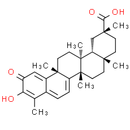Description
Celastrol, also known as tripterine, is a remedial ingredient isolated from the root extracts of Tripterygium Wilfordi (Thunder of God vine) and Celastrus Regelii. In in vitro and in vivo animal experiments, celastrol exhibits antioxidant, anti-inflammatory, anticancer, and insecticidal activities. Celastrol has attracted great interest recently, especially for its potential anti-inflammatory and anti-cancer activities. The anti-inflammatory effects of this triterpene have been demonstrated in animal models of different inflammatory diseases, including arthritis, Alzheimer's disease, asthma, and systemic lupus erythematosus.
Product information
CAS Number: 34157-83-0
Molecular Weight: 450.61
Formula: C29H38O4
Synonym:
Tripterine
Tripterin
Related CAS Number:
193957-88-9 (Dihydrocelastrol)
Chemical Name: 3-Hydroxy-9beta, 13alpha-dimethyl-2-oxo-24, 25, 26-trinoroleana-1(10), 3, 5, 7-tetraen-29-oic acid
Smiles: CC1C2=CC=C3[C@@](C)(CC[C@@]4(C)[C@@H]5C[C@@](C)(CC[C@]5(C)CC[C@@]43C)C(O)=O)C2=CC(=O)C=1O
InChiKey: KQJSQWZMSAGSHN-JJWQIEBTSA-N
InChi: InChI=1S/C29H38O4/c1-17-18-7-8-21-27(4,19(18)15-20(30)23(17)31)12-14-29(6)22-16-26(3,24(32)33)10-9-25(22,2)11-13-28(21,29)5/h7-8,15,22,31H,9-14,16H2,1-6H3,(H,32,33)/t22-,25-,26-,27+,28-,29+/m1/s1
Technical Data
Appearance: Solid Power
Purity: ≥98% (or refer to the Certificate of Analysis)
Solubility: DMSO: 90 mg/mL(199.72 mM). Water: Insoluble.
Shipping Condition: Shipped under ambient temperature as non-hazardous chemical or refer to Certificate of Analysis
Storage Condition: Dry, dark and -20 oC for 1 year or refer to the Certificate of Analysis.
Shelf Life: ≥12 months if stored properly.
Stock Solution Storage: 0 - 4 oC for 1 month or refer to the Certificate of Analysis.
Drug Formulation: To be determined
HS Tariff Code: 382200
How to use
In Vitro:
Celastrol at 5 μM inhibits the chymotrypsin-like, PGPH-like, and trypsin-like activities of the purified 20S proteasome by 80%, 5%, and <1%, respectively, whereas at 10 μM, it inhibits these three proteasomal activities by ∼90%, 15%, and <1%, respectively. Celastrol significantly inhibits the proteasomal chymotrypsin activity in PC-3 cells in a concentration-dependent manner. Celastrol at 2.5 μM to 5 μM induces caspase-3 activity by 4.7-fold to 5.5-fold in PC-3 cells. Celastrol (5 μM) treated cells, the levels of the proteasome target proteins, IκB-α and Bax, are increased after 1 hour and further increased to its peak for 4 hours to 12 hours. Celastrol (2.5 μM) treatment induces proteasome inhibition by 40%, as shown by the decreased levels of chymotrypsin-like activity and increased accumulation of ubiquitinated proteins in LNCaP cells. Celastrol (2.5 μM) induces apoptosis in the Celastrol-treated LNCaP cells, as shown by increased levels of caspase-3 activity (up to 3.5-fold), PARP cleavage, and apoptotic morphology. Celastrol (300 nM) is found to suppress LPS-induced production of TNF-alpha and IL-1beta by human monocytes and macrophages. Celastrol (100 nM) also decreases LPS-induced expression of class II MHC molecules by microglia. Celastrol strongly inhibits LPS and IFN-y-induced NO production with IC50 of 200 nM in macrophage lineage cells. Celastrol strongly inhibits TNF-α and IFN-γ-induced NO production with IC50 of 200 nM in endothelial cells. Celastrol (2.5 μM) potentiates the apoptosis induced by TNF and chemotherapeutic agents and inhibits invasion, both regulated by NF-kappaB activation, in KBM-5 cells. Celastrol (2.5 μM) suppresses the expression of TNF induced the expression of gene products involved in antiapoptosis (IAP1, IAP2, Bcl-2, Bcl-XL, c-FLIP, and survivin), proliferation (cyclin D1 and COX-2), invasion (MMP-9), and angiogenesis (VEGF) in KBM-5 cells. Celastrol (5 μM) is found to inhibit the TNF-induced activation of IkappaBalpha kinase, IkappaBalpha phosphorylation, IkappaBalpha degradation, p65 nuclear translocation and phosphorylation, and NF-kappaB-mediated reporter gene expression. Celastrol inhibits proliferating of RPMI 8226, KATOIII, UM-SCC1, U251MG and MDA-MB-231 cells with IC50 of 0.52 μM, 0.54 μM, 0.76 μM, 0.69 μM and 0.67 μM, respectively. Celastrol (1 μM) inhibits growth of RPMI 8226 with a decrease in the levels of cyclin D1 and cyclin E, but concomitant increase in the levels of p21 and p27. Celastrol induces apoptosis in RPMI-8226 cells indicated by the activation of caspase-8, bid cleavage, caspase-9 activation, caspase-3 activation, PARP cleavage and through the down regulation of anti-apoptototic proteins. Celastrol (1 μM) suppresses Akt pathway and activates JNK kinase in RPMI-8226 cells.
In Vivo:
Celastrol (3 mg/kg) results in significant inhibition (up to 70%) of tumor growth in male nude mice bearing PC-3 tumors, associated with increased p27 levels and Bax level. Celastrol (3 mg/kg) results more apoptotic tumor cells with the appearance of various PARP cleavage fragments in tumor of male nude mice bearing PC-3 tumors. Celastrol (3 mg/kg) causes 35% of tumor inhibition, associated with decreased proteasome activity and decreased expression of AR protein in nude mice bearing C4-2B tumors. Celastrol (3 mg/kg) is found to suppress strongly joint swelling and other manifestations of adjuvant arthritis in mice. Celastrol (0.2 mg/kg) significantly improves the performance in memory, learning and psychomotor activity tests in rats.
References:
- Sethi G, et al. Blood, 2007, 109(7), 2727-2735.
- Allison AC, et al. Prog Neuropsychopharmacol Biol Psychiatry, 2001, 25(7), 1341-1357.
- Yang H, et al. Cancer Res, 2006, 66(9), 4758-4765.
Products are for research use only. Not for human use.
Payment & Security
Your payment information is processed securely. We do not store credit card details nor have access to your credit card information.


